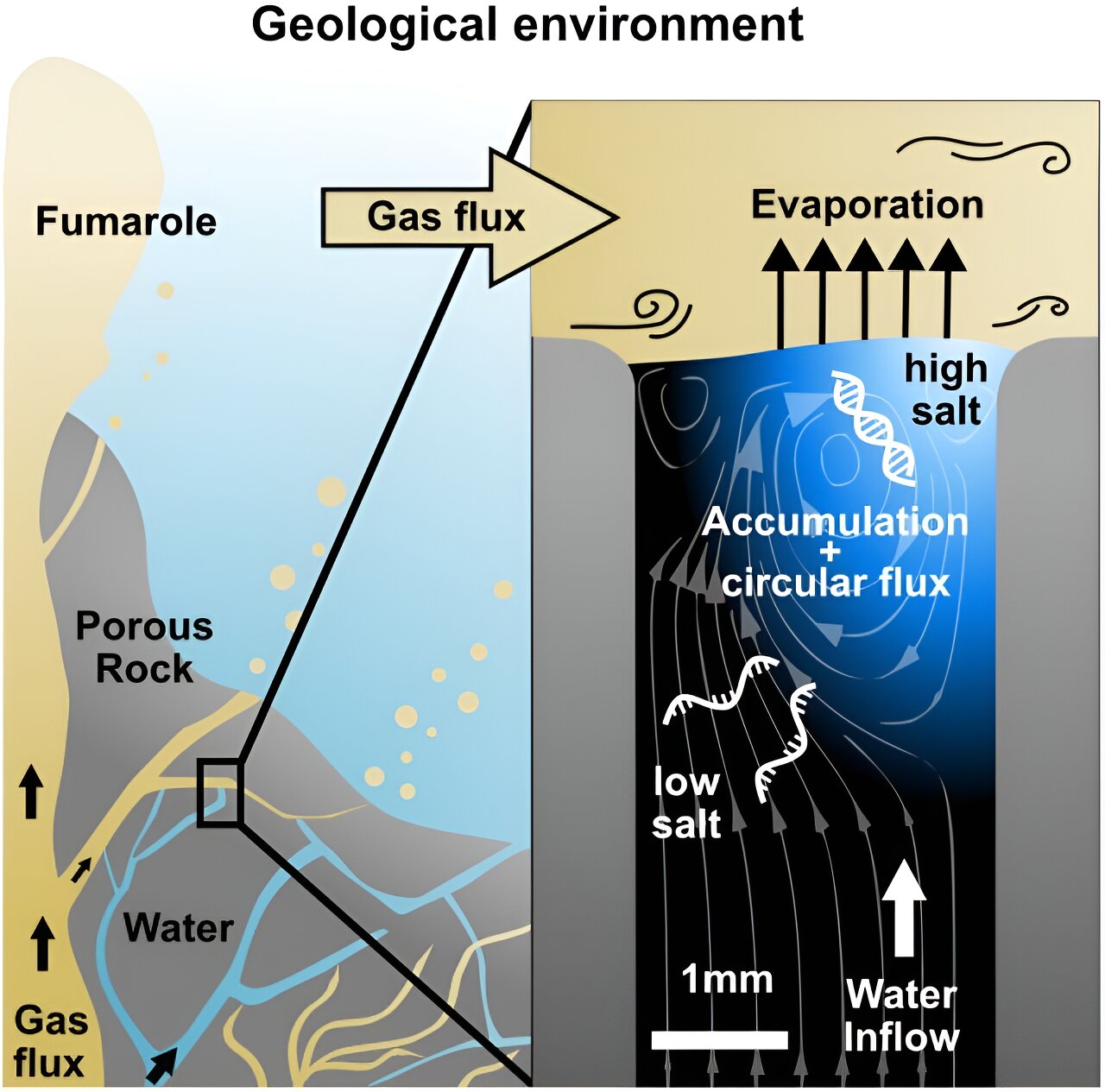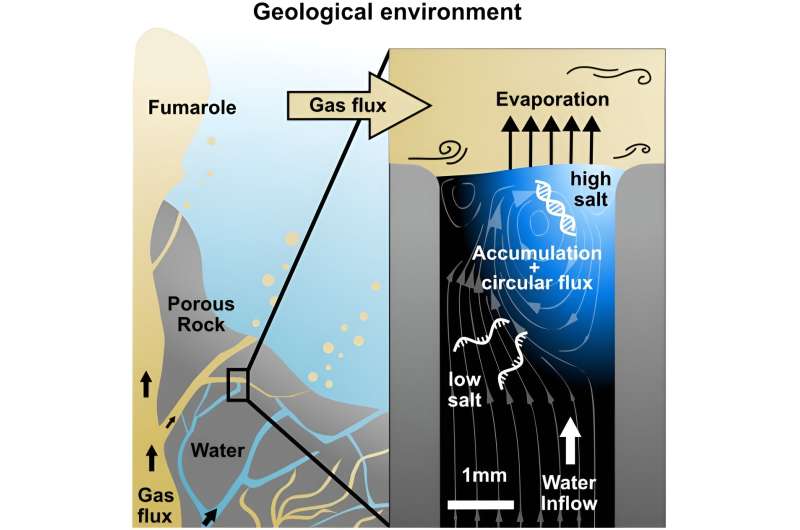

Researchers have discovered a plausible evolutionary setting in which nucleic acids—the fundamental genetic building blocks of life—could enable their own replication, possibly leading to life on Earth.
The study, published today as a Reviewed Preprint in eLife, was described by editors as important work with convincing evidence to show how a simple geophysical setting of gas flow over a narrow channel of water can create a physical environment that leads to the replication of nucleic acids. The work will be of interest to scientists working on the origin of life, and more broadly, on nucleic acids and diagnostic applications.
The emergence of life on Earth is still an unsolved puzzle, but a common theory is that replication of genetic material—the nucleic acids DNA and RNA—was a central and critical process. RNA molecules can store genetic information and catalyze their own replication through forming double-stranded helices. The combination of these abilities allows them to mutate, evolve and adapt to diverse environments and ultimately encode the protein building blocks of life.
For this to happen, strands of RNA need not only to replicate into a double-stranded form, but also to separate again to complete the replication cycle. Strand separation, however, is a difficult task at the high salt and nucleic acid concentrations required for replication.
“Various mechanisms have been studied for their potential to separate DNA strands at the origin of life, but they all require temperature changes that would lead to degradation of nucleic acids,” says lead author Philipp Schwintek, a Ph.D. student in Systems Biophysics at Ludwig-Maximilians-Universität München, Munich, Germany.
“We investigated a simple and ubiquitous geological scenario where water movement through a rock pore was dried by a gas percolating through the rock to reach the surface. Such a setting would be very common on volcanic islands on early Earth which offered the necessary dry conditions for RNA synthesis.”
The team built a laboratory model of the rock pore featuring an upward water flux evaporating at an intersection with a perpendicular gas flux, which leads to an accumulation of dissolved gas molecules at the surface. At the same time, the gas flux induces circular currents in the water, forcing molecules back into the bulk. To understand how this model would affect nucleic acids within the environment, they used beads to monitor the dynamics of the water flow and then tracked the movement of fluorescently labeled short DNA fragments.
“Our expectation was that continuous evaporation would lead to an accumulation of DNA strands at the interface,” says Schwintek. “Indeed, we found that water continuously evaporated at the interface but the nucleic acids in the aqueous face accumulated near the gas/water interface.” Within five minutes of starting the experiment, there was a three-fold accumulation of DNA strands, whereas after an hour, there were 30 times more DNA strands accumulated at the interface.
Although this suggests that the gas/water interface allows for a sufficient concentration of nucleic acids for replication to occur, separation of the double DNA strands is also necessary. Usually a change in temperature is required, but when the temperature is constant, changes in salt concentration are necessary.
“We hypothesized that the circular fluid flow at the interface provided by the gas flux, alongside passive diffusion, would drive strand separation by forcing the nucleic acids through areas with different salt concentrations,” explains senior author Dieter Braun, Professor of Systems Biophysics at Ludwig-Maximilians-Universität München.
To test this, they used a method called FRET spectroscopy to measure DNA strand separation—a high FRET signal shows DNA strands are still bound, whereas a low FRET indicates the strands are separated. As anticipated, the FRET signal increased initially near the gas-water interface, indicating the formation of double-stranded DNA. But over the course of the experiment, where there was an upward flow of water, the FRET signal was low—indicating single strand DNA.
Moreover, when the team overlaid this data with their simulation of water flow and salt concentrations, they found that the vortex at the gas-water interface caused changes of up to three-fold increases in salt concentrations, potentially capable of driving strand separation.
Although nucleic acids and salts accumulated near the gas-water interface, in the bulk of the water the concentrations of salt and nucleic acids remained vanishingly low. This prompted the team to test whether nucleic acid replication could really happen in this environment, by adding nucleic acids labeled with a fluorescent dye and an enzyme that can synthesize double-stranded DNA into the laboratory model of the rock pore. Unlike normal laboratory DNA synthesis reactions, the temperature was maintained at a constant temperature and the reaction was instead exposed to the combined water and gas influx.
After two hours, the fluorescent signal had increased, indicating an increased number of replicated double-stranded DNA molecules. Yet, when the gas and water influx were switched off, no increase in fluorescence signals was observed, and therefore no increase in double-stranded DNA was seen.
“In this work we investigated a plausible and abundant geological environment that could trigger the replication of early life,” concludes Braun. “We considered a setting of gas flowing over an open rock pore filled with water, without any change in temperature, and found that the combined gas and water flow can trigger salt fluctuations which support DNA replication.
“Since this is a very simple geometry, our findings greatly extend the repertoire of potential environments that could enable replication on early planets.”
More information:
Philipp Schwintek et al, Prebiotic gas flow environment enables isothermal nucleic acid replication, eLife (2024). DOI: 10.7554/eLife.100152.1
Journal information:
eLife
Citation:
Scientists find plausible geological setting that may have sparked life on Earth (2024, October 1)
retrieved 1 October 2024
from https://phys.org/news/2024-10-scientists-plausible-geological-life-earth.html
This document is subject to copyright. Apart from any fair dealing for the purpose of private study or research, no
part may be reproduced without the written permission. The content is provided for information purposes only.